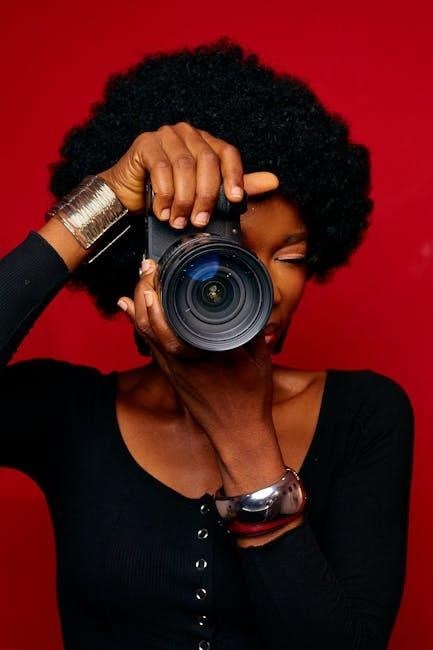guide to camera shots pdf
Camera shots are fundamental in visual storytelling, shaping the narrative and emotional impact. This guide explores essential concepts, helping creators master techniques to enhance their work effectively.
1.1 Importance of Camera Shots in Filmmaking and Photography
Camera shots are essential for visual storytelling, dictating composition and emotional impact. They guide audience attention, convey mood, and enhance narrative depth. Mastering camera shots allows filmmakers and photographers to communicate effectively, ensuring each frame serves the story, making them a cornerstone of creative expression and technical precision in both mediums.
1.2 Brief Overview of the Guide to Camera Shots PDF
The guide provides a comprehensive overview of camera shots, angles, and movements, offering practical tips for filmmakers and photographers. It covers essential techniques like framing, composition, and storytelling through visuals. Designed as a quick reference, the PDF helps creators enhance their craft, ensuring every shot communicates effectively and elevates their work.
Types of Camera Shots
Camera shots vary from extreme long to close-up, each serving unique storytelling purposes. Understanding these types helps filmmakers convey emotions and focus effectively in their scenes.
2.1 Extreme Long Shot
The extreme long shot captures subjects from a great distance, often showing the environment more than the subject itself. This shot is used to establish settings or emphasize the vastness of a scene. It helps viewers understand spatial relationships and provides context, making it ideal for outdoor or landscape-focused storytelling in film and photography.
2.2 Long Shot
A long shot frames the subject from head to toe, capturing both the subject and their surroundings. It provides context and establishes the scene, making it ideal for showing the relationship between the subject and the environment. This shot is commonly used in film and photography to create a balanced composition and convey the scale of the setting.
2.3 Medium Shot
A medium shot frames the subject from the waist up, balancing the person and their surroundings. It captures facial expressions while providing context, making it ideal for dialogue scenes. This versatile shot is widely used in filmmaking and photography to convey emotion and maintain viewer engagement, offering a balance between detail and environment;
2.4 Close-Up Shot
A close-up shot tightly frames the subject, often focusing on their face or a specific object. It emphasizes emotions, textures, or details, creating a strong visual impact. This shot is essential for conveying intense emotions or highlighting key elements in a scene, making it a powerful tool in storytelling and visual composition.
2.5 Extreme Close-Up Shot
An extreme close-up shot focuses tightly on a specific detail, such as eyes, lips, or textures, isolating it from the surroundings. This shot is used to convey intense emotion, highlight crucial elements, or create a dramatic emphasis, drawing the audience’s attention to a particular aspect of the scene for heightened storytelling impact.
Camera Angles
Camera angles influence the scene’s emotional tone and narrative perspective, guiding viewer focus. They include low-angle, high-angle, eye-level, and Dutch angles, each conveying unique storytelling intent and visual emphasis.
3.1 Low-Angle Shot
A low-angle shot frames the subject from below, creating a sense of power or heroism. This perspective emphasizes height and grandeur, often used to portray confidence or intimidation. It places the audience in a position of looking up, enhancing the subject’s dominance in the scene. This technique is widely used in storytelling to evoke specific emotional responses.
3.2 High-Angle Shot
A high-angle shot captures the subject from above, often creating a sense of vulnerability or powerlessness. This perspective can make the subject appear small or insignificant, emphasizing their isolation or weakness. It also provides a broader view of the scene, highlighting the environment. Commonly used in dramas, this shot helps convey emotions like sadness or helplessness effectively.
3.3 Eye-Level Shot
An eye-level shot frames the subject at their natural height, creating a neutral perspective. This shot places the camera at the subject’s eye level, making the audience feel connected and equal to the subject. It minimizes emotional manipulation, providing an objective view. Often used in close-ups and medium shots, it builds intimacy and empathy, making it essential for storytelling and character development.

3.4 Dutch Angle Shot
The Dutch Angle Shot tilts the camera to create a sense of unease or tension. This technique adds visual drama, often used in thrillers or horror to signal something is wrong. It’s a powerful tool to evoke specific emotions and engage the audience effectively in storytelling.

Camera Movements
Camera movements add depth and emotion to scenes through techniques like dolly, tracking, pan, tilt, and crane shots. These movements guide the audience’s focus and enhance storytelling dynamically.
4.1 Dolly Shot
A dolly shot involves moving the camera toward or away from the subject on a track, creating smooth transitions. It enhances emotional depth and adds dynamic movement to scenes without camera shake, allowing for precise control over the narrative’s pacing and focus.
4.2 Tracking Shot
A tracking shot follows a moving subject, capturing its movement seamlessly. This technique creates dynamic compositions, adding depth and engagement to scenes. By maintaining focus on the subject while moving alongside it, tracking shots convey action, emotion, and context, enhancing the visual storytelling and immersing the audience in the narrative flow effectively.
4.3 Pan Shot
A pan shot involves moving the camera horizontally from side to side, capturing a wide scene or following a subject. This technique establishes settings, conveys movement, and adds visual interest. Panning creates a smooth transition, guiding the audience’s attention while maintaining focus on the subject or landscape, enhancing storytelling and visual depth effectively in both film and photography.
4.4 Tilt Shot
A tilt shot involves moving the camera upward or downward to reveal or emphasize elements within the frame. This technique adds dramatic effect, highlights scale, or draws attention to specific details. Tilt shots are often used to create a dynamic visual experience, guiding the audience’s focus and enhancing the emotional impact of a scene in both film and photography effectively.
4.5 Crane Shot
A crane shot involves elevating or lowering the camera from a fixed point, often to capture sweeping vistas or dramatic shifts in perspective. This movement enhances storytelling by revealing context, emphasizing scale, or creating emotional depth. Crane shots are particularly effective in establishing scenes, showcasing grandeur, or highlighting action, making them a powerful tool in visual storytelling and cinematic expression.
Framing and Composition
Framing and composition are essential for organizing visual elements, guiding the viewer’s attention, and creating balanced, aesthetically pleasing images in photography and filmmaking.
5.1 Rule of Thirds
The Rule of Thirds is a fundamental composition technique where the frame is divided into thirds horizontally and vertically, creating nine equal parts. Important elements are placed along these lines or at their intersections to create balance and visual interest. This method avoids centering the subject, enhancing storytelling and emotional impact in both photography and filmmaking.
5.2 Leading Lines
Leading lines are compositional elements that guide the viewer’s eye toward the subject, creating depth and direction. These lines can be natural, like roads or shorelines, or man-made, such as fences or pathways. By incorporating leading lines, photographers and filmmakers draw attention to the focal point, enhancing the visual narrative and emotional impact of the image or scene.
5.3 Depth of Field
Depth of field controls the focus area in an image, separating subjects from backgrounds. A wide aperture (e.g., f/2.8) creates a shallow depth, blurring backgrounds, while a narrow aperture (e.g., f/11) keeps more in focus. This technique isolates subjects, emphasizes context, and directs viewer attention, enhancing storytelling and visual impact in both photography and filmmaking compositions.

Practical Tips for Using Camera Shots
Master camera shots by experimenting with angles, movements, and framing. Practice storytelling through shot selection and use depth of field to emphasize subjects effectively in every frame.
6.1 Enhancing Storytelling Through Shot Selection
Shot selection is crucial for guiding the audience’s focus and evoking emotions. Use close-ups to highlight expressions, wide shots for context, and dynamic angles to build tension. By varying shot types, filmmakers create visual rhythm, drawing viewers into the narrative and reinforcing the story’s themes and character development effectively.
6.2 How to Frame Subjects Effectively
Effective framing focuses attention on the subject, using techniques like the rule of thirds and leading lines to guide the viewer’s eye. Depth of field isolates subjects, while balanced composition ensures visual harmony. Negative space can emphasize simplicity, making the subject stand out. These methods enhance storytelling and create engaging, visually appealing shots.
6.3 Using Camera Movements to Convey Emotion
Camera movements like dolly, tracking, and crane shots can evoke emotions by dynamically engaging the audience. A dolly-in creates intimacy, while a crane shot conveys grandeur or isolation. Panning and tilting guide focus, adding tension or wonder. These movements subtly enhance storytelling, aligning visual language with emotional intent to deepen viewer connection and immersion in the scene.

Downloading the Free PDF Guide
Access the free PDF guide to camera shots, offering a quick reference for filmmakers and photographers. Download now and explore essential techniques to enhance your craft.
7.1 Benefits of the Camera Shots PDF Guide
The Camera Shots PDF Guide offers a comprehensive overview of essential techniques, enhancing storytelling through shot selection. It provides practical tips for framing subjects and using camera movements effectively. This guide is a valuable resource for filmmakers and photographers, helping them master visual storytelling and elevate their craft with clear, concise instruction.
7.2 How to Access the Guide
Accessing the Camera Shots PDF Guide is straightforward. Simply visit the provided link, click the download button, and save the file. Ensure compatibility with your device for easy viewing. This guide is available for free, offering instant access to expert tips and techniques to enhance your filmmaking and photography skills.

